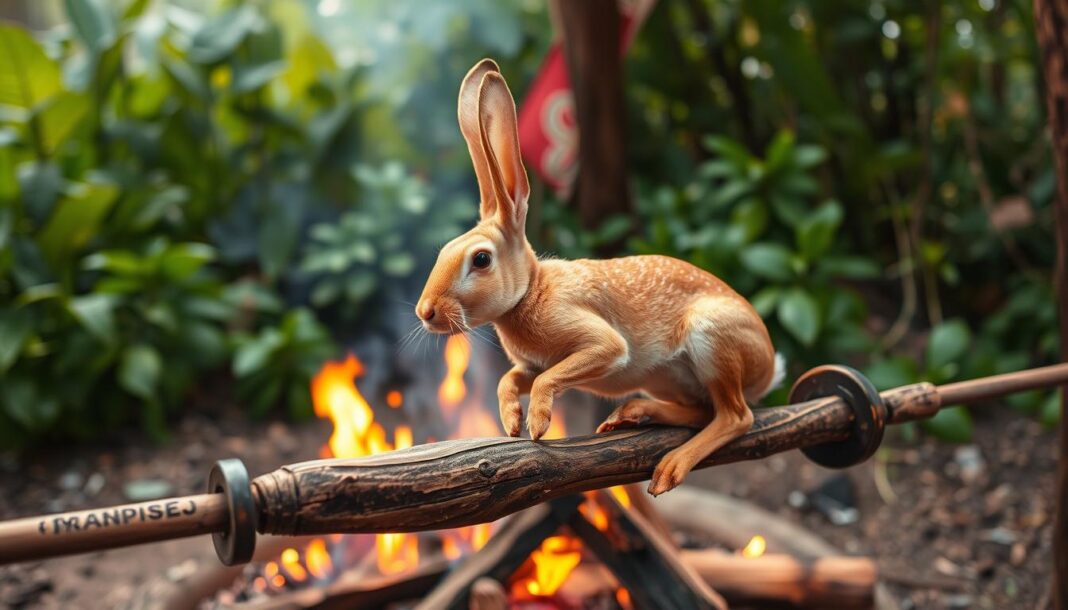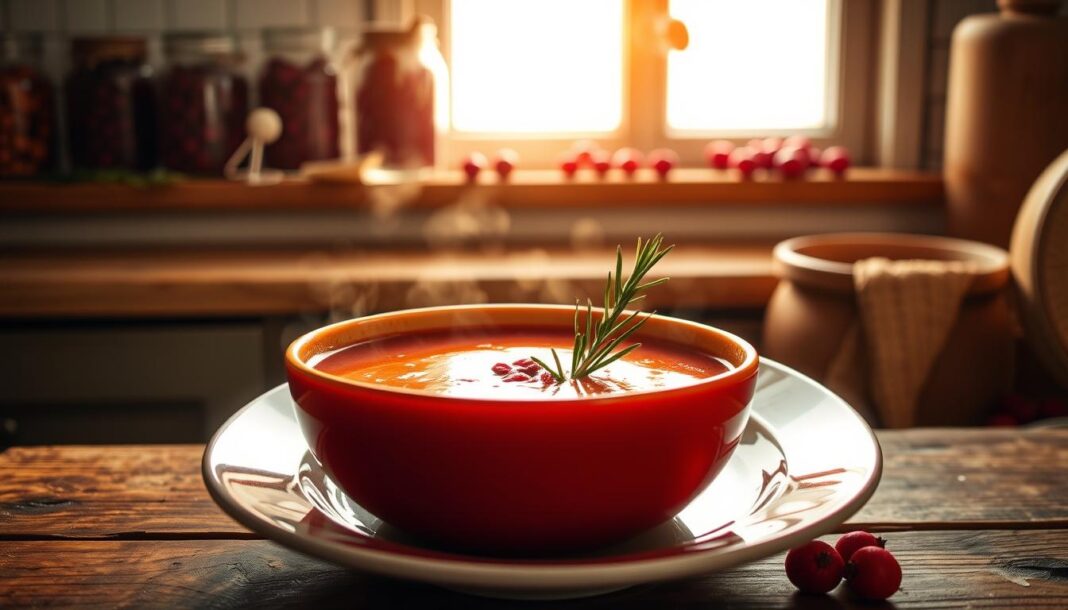Cooking rabbit on a spit is an ancient tradition that yields exceptionally flavorful results. Despite being underappreciated in modern American cuisine, rabbit meat remains a culinary delicacy in many cultures. We will explore the art of spit-roasting rabbit, a method that requires attention to detail and a understanding of the cooking process.
The process involves more than just placing the rabbit over a fire; it requires proper preparation, a well-chosen marinade, and careful management of cooking time and fire. By mastering these elements, home cooks can achieve a dish that is both tender and full of flavor.
Key Takeaways
- Understanding the basics of spit-roasting and its benefits.
- Learning how to prepare rabbit for spit-roasting.
- Selecting the right marinade for enhanced flavor.
- Managing cooking time and fire for optimal results.
- Achieving tender and flavorful results through proper technique.
The Culinary Tradition of Spit-Roasted Rabbit
The tradition of spit-roasting rabbit is a culinary practice that spans centuries, deeply rooted in various cultures around the world. This method of cooking has been cherished not only for its ability to bring out the unique flavors of the rabbit but also for its role in bringing people together.
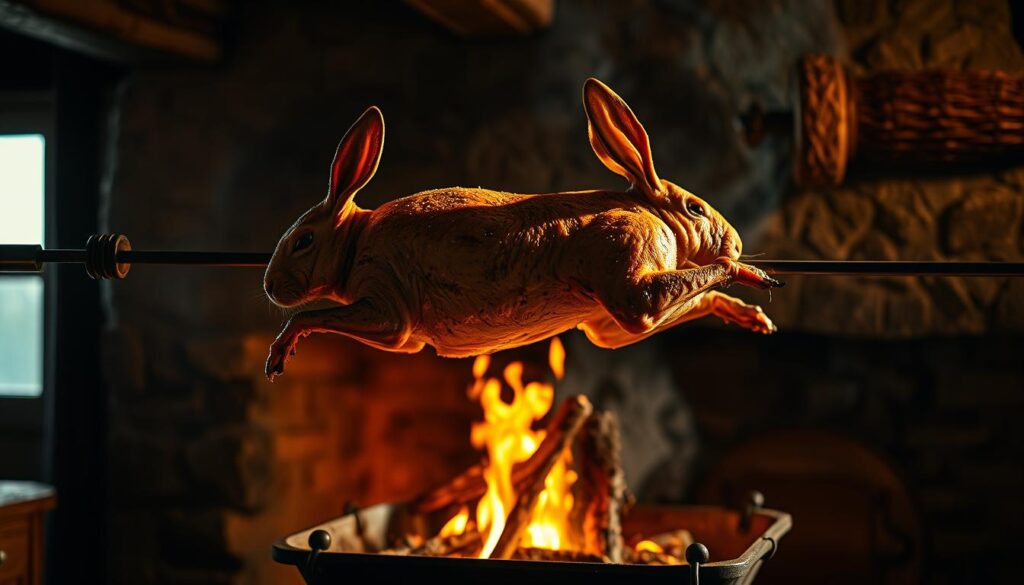
Historical Significance of Rabbit in Traditional Cuisine
Rabbit has been a staple in many traditional cuisines, particularly in Italy and other Mediterranean countries. Historically, rabbit was considered a delicacy and was often served at special occasions. Many dishes that are now commonly made with chicken, such as cacciatora, originally used rabbit as the main ingredient, highlighting the versatility and culinary value of this meat.
Why Spit Roasting Creates Unique Flavors
Spit roasting is a cooking method that involves rotating the meat over an open flame, ensuring even cooking and browning. This technique not only enhances the texture of the rabbit but also infuses it with a smoky flavor that is hard to achieve with other cooking methods. The continuous rotation ensures that the meat is cooked uniformly, retaining its juices and tenderness.
Nutritional Benefits of Rabbit Meat
Rabbit meat is renowned for its nutritional benefits. It is high in protein, low in fat, and contains essential micronutrients such as B vitamins, phosphorus, and potassium. The nutritional profile of rabbit meat makes it an excellent choice for those seeking a healthy and sustainable alternative to more traditional meats.
| Nutrient | Rabbit Meat | Chicken Breast | Beef |
|---|---|---|---|
| Protein (%) | 21.0 | 31.0 | 26.0 |
| Fat (%) | 4.0 | 3.6 | 15.0 |
| Calories (kcal/100g) | 126 | 165 | 250 |
As shown in the table, rabbit meat compares favorably to other meats in terms of its nutritional content, offering a lean and protein-rich option for consumers.
Preparing Your Rabbit for the Spit
A well-prepared rabbit is the foundation of a successful spit-roasting endeavor, and we’re here to guide you through it. Proper preparation not only enhances the flavor but also ensures that the meat is tender and juicy.
Selecting and Cleaning the Rabbit
The first step in preparing your rabbit is selecting a fresh, high-quality specimen. Look for a rabbit with clear eyes, firm flesh, and a pleasant aroma. Once you’ve selected your rabbit, it’s essential to clean it thoroughly. Rinse the rabbit under cold running water, then pat it dry with paper towels to remove excess moisture.
Essential Marinade Ingredients
A good marinade is crucial for adding depth and complexity to your spit-roasted rabbit. The marinade typically consists of a combination of herbs, aromatics, oils, and acids.
Herbs and Aromatics
Herbs like thyme, rosemary, and sage, along with aromatics such as garlic and onions, form the backbone of a flavorful marinade. These ingredients not only add taste but also contribute to the aromatic experience of the dish.
Oils and Acids
Oils, such as olive oil, help to keep the meat moist, while acids like lemon juice or vinegar work to tenderize it. A balance between these components is key to a successful marinade.
Marinating Techniques and Timing
Place the rabbit in a large bowl or zip-top bag, cover it with your marinade, and then refrigerate. You can marinate the rabbit for as little as an hour or as long as overnight – typically between 2 to 24 hours. The key is to find the right balance; too little time, and the flavors won’t penetrate; too much time, and the meat can become mushy. If you’re using a dry brine with salt and herbs, ensure the rabbit is refrigerated and turned occasionally to promote even distribution of flavors.
For more detailed information on cooking other game meats, you might find our guide on how to cook deer meat in the helpful.
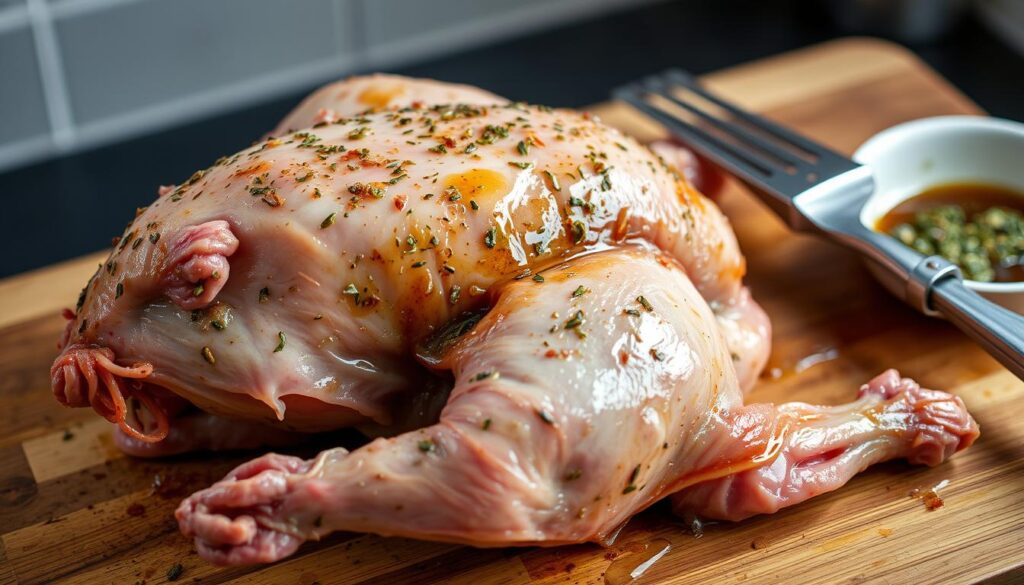
Mastering the Rabbit on a Spit Technique
The technique of roasting rabbit on a spit is both an art and a science, requiring a deep understanding of the cooking process. To achieve a perfectly cooked rabbit, several key steps must be mastered.
Setting Up Your Spit and Fire
Setting up your spit and fire correctly is crucial for even cooking. Ensure your spit is sturdy and level, and that your fire is at a consistent temperature. We recommend using a mix of hardwoods for a balanced heat.
Securing the Rabbit Properly
Securing the rabbit properly on the spit is vital to prevent it from rotating unevenly or falling off during cooking. Use skewers or ties to secure the rabbit firmly in place, making sure it’s evenly balanced.
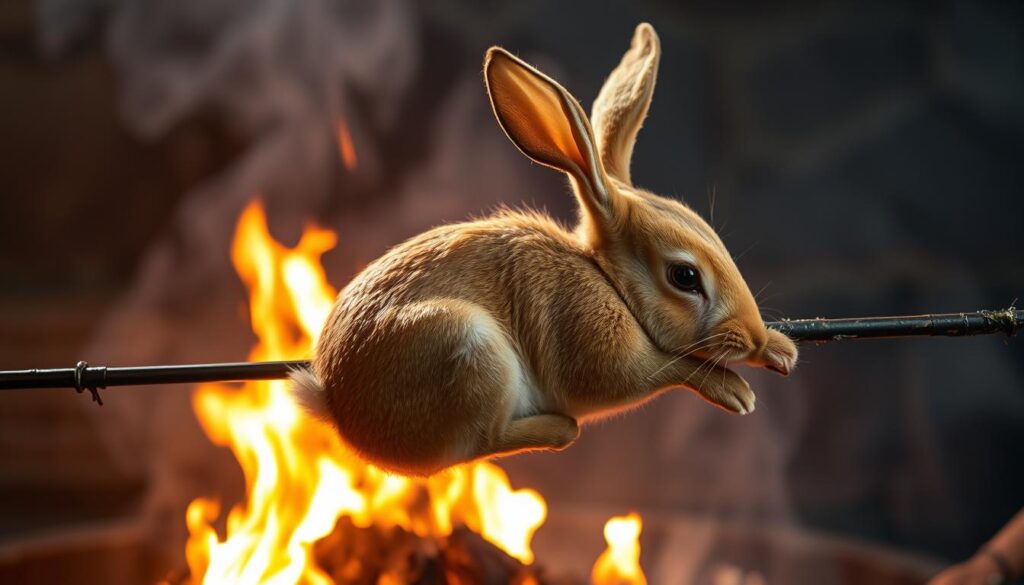
Temperature Control and Cooking Time
Maintaining the right temperature is crucial for cooking the rabbit to perfection. Aim for a medium heat, and cook for about 45 minutes to an hour, depending on the size of the rabbit. Regularly check the internal temperature to ensure it reaches a safe minimum.
Basting Methods for Moist, Flavorful Meat
Basting the rabbit with a reserved marinade is essential for maintaining moisture and enhancing flavor. Baste the rabbit every 10-15 minutes, and consider replenishing the drippings pan with water or wine to prevent drying out. Using a marinade not only adds flavor but also helps in keeping the meat moist throughout the cooking process.
By mastering these techniques, you’ll be able to achieve a deliciously cooked rabbit with a crispy exterior and juicy interior, making your dining experience truly satisfying.
From Spit to Plate: Serving Your Roasted Rabbit
As we conclude our journey through the traditional method of cooking rabbit on a spit, it’s time to bring our perfectly roasted rabbit to the table. After cooking, let the rabbit rest for 10-15 minutes before carefully removing it from the spit. This crucial step allows the juices to redistribute throughout the meat, ensuring optimal moisture and flavor.
Once rested, carefully remove rabbit from the spit, cut away the kitchen strings, and carve it into serving pieces. To enhance the natural flavors, season with salt and pepper, and drizzle with a bit of olive oil. The final seasoning is crucial as it elevates the dish with a light application of quality ingredients.
For serving, consider traditional and contemporary suggestions such as pairing with classic side dishes, complementary sauces, or a glass of white wine. The versatility of rabbit meat also shines in subsequent meals, where it can be repurposed in salads, pasta dishes, or as a creative addition to other recipes. Proper storage techniques, including refrigeration and reheating methods, will preserve the moisture and flavor of leftover meat.
The cultural significance of communal dining around spit-roasted meats brings people together, creating shared food experiences that are both memorable and delicious. By following these steps, we not only enjoy a delectable meal but also participate in a culinary tradition that spans centuries.
